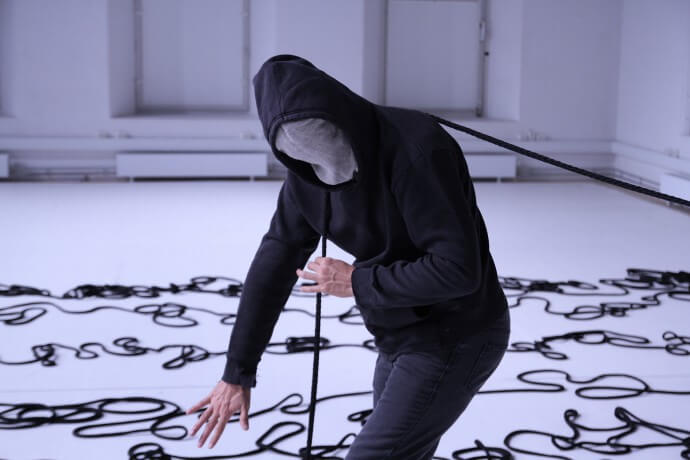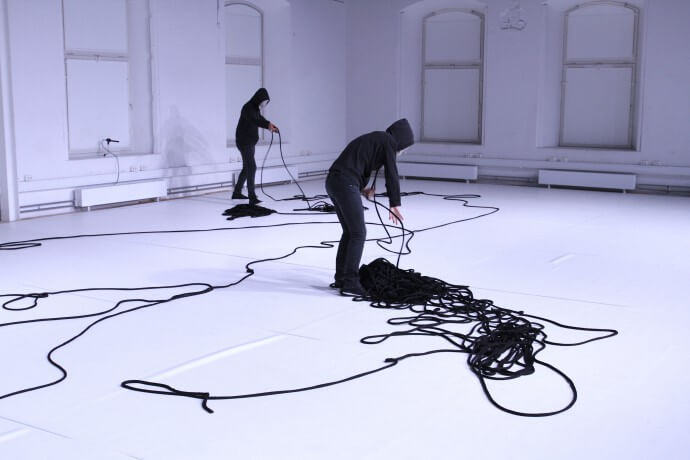
An immersion into the forces seeking to destroy the forms
Beauty of Accident
(2012 – 2013)
Two people are attached to a rope, the rope that evidently refers to, but not strictly speaking, Ariadne’s thread, the safety wire, webs, the thread of destiny, the cord that links us to each other, the concept of rhizome, the thread between life and death.
Is it possible to liberate movement from time through repetition that is never repeated identically? How can these bodies be in permanent difference? What would happen within an attempt of the bodies to penetrate the field of rhythms? Or even, would it be possible in the field of performing arts to penetrate the territory of rhythm? Understanding rhythm as something that never repeats itself, ‘an absence of periodic repetitions’, i.e. permanent inequality. For better understanding we made a necessary distinction between rhythm and cadence, comprehend the concept of rhythm through the following definition: ‘The force that life finds in order to engage itself in chaos.’
This project is the last part of the second trilogy of the Brazilian/Swedish duo QUARTO. The research was initiated in January 2012 in Brazil and continued during an artistic residence at The Swedish Arts Grants Committees studio under the International Dance Programme, a two year long residence at SITE (Production Center for Performing Arts), Stockholm and a month long residence at INKONST in Malmö and MDT Stockholm.
In ‘Beauty of Accident’ QUARTO continues their research within an artistic practice allied to choreography x philosophy.
What happens to the body when dealing with an object? Or when an object is imposed on the body? How can movement originate from an object? How to return to the object it’s subjectivity, once lost, in order for it to become object and serve a function? How can the object be redefined? What types of force do these bodies evoke? How can perception be provoked or affected through the manipulation of the object? What is an object?
Would an object be the mode of perceiving a body? The mode of perceiving an interested body? There is always a relation of interest between the subject and object. For example, a rope is one thing when used to bind or hold something together, and another thing when used to threaten someone, which then becomes a weapon. So the rope in itself does not exist, but rather a manner of use.
Two people are attached to a rope, the rope that evidently refers to, but not strictly speaking, Ariadne’s thread, the safety wire, webs, the thread of destiny, the cord that links us to each other, the concept of rhizome, the thread between life and death.
Is it possible to liberate movement from time through repetition that is never repeated identically? How can these bodies be in permanent difference? What would happen within an attempt of the bodies to penetrate the field of rhythms? Or even, would it be possible in the field of performing arts to penetrate the territory of rhythm?Understanding rhythm as something that never repeats itself, ‘an absence of periodic repetitions’, i.e. permanent inequality. For better understanding we made a necessary distinction between rhythm and cadence, comprehend the concept of rhythm through the following definition: ‘The force that life finds in order to engage itself in chaos.’
How important is the empty and undefined space, present in the series ‘Beauty’?
Emptiness is QUARTOS entrance into the territory of subjectivity, seeking to undo pre-established forms and plunge into the field of forces, what Nietzsche calls ‘active forces’; an immersion into the forces seeking to destroy the forms.
The starting point for the research and experimentation lies in the impulses generated by forces that potentiate us, forces within each one of us. How can we prevent the forces that make us weak and anguished to govern our lives? These forces that define our identity, function, habits, relationship with others and with objects. Supposedly, we would say that ‘Beauty of Accident’ is the desire to deal with vibrations and intensities. With that QUARTO chooses to dissolve the presence of the performer that through actions generate certain habits, psychological representations, a character, common sense, the relations of duality and opposition between two bodies, woman, man, ceasing the ego and drama. Thus trying to create an impersonal presence, an empty being, without a personal story or plot.
Evidently, as artists, we create something with the desire to affirm, express and challenge ourselves in the field of forces and thought. What is produced only reveals one of the moments of what we do. We are involved intensively with these issues all the time, and due to this degree of intensity we can generate an artistic production – maybe generate modes of existence – continue problematizing with tireless insistence, perhaps understand better what surrounds us and therefore, let our questions lead us to break paradigms and generate new questions, or, going even further, lead us to new ways of living.
Series BEAUTY: FEAR (2010-2011)/DESPAIR (2011-2012)/ACCIDENT (2012-2013)
This is QUARTOS second series that initiated 2010, the result of a praxis that evolves from a long-term process based research. What has beauty got to do with all of this? Fear seems to be the contemporary Beauty in controlling people through the lack of courage, Despair on the other hand disorganizes Beauty, crushes the harmony and creates disorder, while Accident is the Beauty in non essential causes, the possibility for the unforeseen. QUARTO is investigating Beauty in new contexts, in places seemingly far from finding it.
World premiere // JAN 31-2 2013 at INKONST MDT STOCKHOLM // MAR 15-16 — October 3-4 2013 Toured: 15 countries.
Choreography, concept & performance: Anna Mesquita & Leandro Zappala. Sound design: Philippe Boix-Vives. Video: Palle Lindqvist. Poet: Naima Chahboun. Philosopher: Fredrika Spindler. Graphic design & production: QUARTO. Sponsor: Pille Repmakarn.
Co-production: SITE production center for performing arts
Supported by: The Swedish Arts Council, Stockholm’s Culture Committee and The International Dance Programme – The Swedish Arts Grants Committeé’s International Programme for Dance Artists












